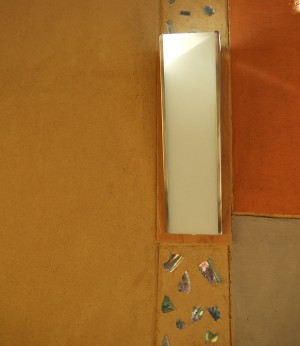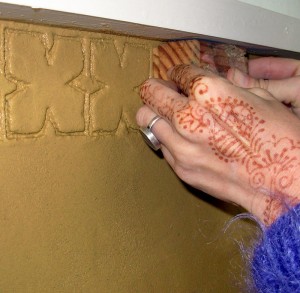 SOLID EARTH LTD take pride in their high quality earthen plasters.
SOLID EARTH LTD take pride in their high quality earthen plasters.
Through the application of earthen plasters it is possible to provide a healthy & non toxic interior wall surface and thus to reap the benefits of clay building products within a conventional house.
Please feel free to contact us to discuss your requirements and for a free measure and quote.
Building materials that can be plastered with Earth are:
Contemporary sleek and smooth, but not dead flat finish. Other textures can be achieved on request. Sealed with clear casein wash for durability and dust proofing.
Our standard clay colours are golden yellow and near white. We can achieve other colour tones based on yellow, red and black iron oxides.
 Artistic Features
Artistic FeaturesWe can integrate artistic features according to your specifications or of our own design.
Visit our Photo Gallery for a visual impression
For us, advocating natural earthen plasters as part of an interior wall system is linked to their great ability to regulate indoor humidity and temperature, as well as the fact that they are totally natural, breathable and have a very small carbon footprint. Furthermore earthen plaster offer nearly unlimited aesthetic and artistic possibilities.
Porous materials have the ability to absorb humidity from the air (vapour) and release it back into the air. This humidity balancing potential is especially effective with clay. A solid wall of earth bricks can absorb up to thirty times the moisture of conventional burnt bricks. A thin layer of earthen plaster is still able to absorb an exceptional amount of water.
These remarkable humidity balancing properties may cause people to believe that clay building products, by absorbing moisture, would be setting up the perfect conditions for the growth of mould or the onset of fungal rot. However, the opposite is true: Ideal conditions for mould or rot are caused when a building material absorbs moisture and is unable to later release it when air humidity drops, as in the case of absorbed water becoming trapped behind oil based painted surfaces, or when moisture is not absorbed but condensates on a surface. This makes even bathroom and kitchen walls built from clay or rendered with clay more hygienic and far less vulnerable to the growth of mould than for example tiled walls.